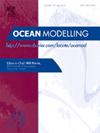Tidal estimates from sun-synchronous satellite altimeters in the Bohai Sea via an improved harmonic analysis model
IF 2.9
3区 地球科学
Q2 METEOROLOGY & ATMOSPHERIC SCIENCES
引用次数: 0
Abstract
Multi-satellite altimeters have greatly elevated our understanding of tidal dynamics around the globe. Among all publicly available satellite altimeters, the T/P-Jason series are widely considered as the core of diverse satellite-based tidal investigations. By contrast, sun-synchronous satellites only play auxiliary roles in previous studies mostly due to their pathological aliasing for tidal estimation. In this study, MHACS, an improved version of the classical harmonic analysis model utilizing the smooth nature of tidal admittances, is applied to estimate tidal constants from 24-year sun-synchronous ERS-Envisat-Saral (EES) series in the Bohai Sea. MHACS utilizes the intrinsic natural connections among major tidal constituents to overcome the restrictions of the Rayleigh criterion. Tricky K1-P1-Sa and K2-Ssa pairs as well as S2 tides in EES series are resolved by MHACS with regularization algorithms (i.e. ridge regression). Practical experiments in the Bohai Sea suggest that tidal estimates from the EES series through MHACS are in high agreement with the FES2014, with an average error of only 2.18 cm. Such consistency indicates the satisfactory performance of MHACS with ridge regression on processing the EES series. Although the proposed method has some limitations, it can potentially be a widely-used tool to extract tides from heterogeneous satellite altimeters including Sentinel series and Surface Water Ocean Topography (SWOT).
基于改进谐波分析模型的太阳同步卫星高度计对渤海潮汐的估计
多卫星高度计极大地提高了我们对全球潮汐动力学的认识。在所有公开的卫星高度计中,T/P-Jason系列被广泛认为是各种卫星潮汐调查的核心。相比之下,太阳同步卫星在以往的研究中只起到辅助作用,主要是由于其在潮汐估计中的病理混叠。本文利用经典调和分析模型的改进版本MHACS,利用潮汐导纳的平滑特性,对24年太阳同步es - envisat - saral (EES)系列的渤海潮汐常数进行了估计。MHACS利用主要潮汐成分之间固有的自然联系来克服瑞利准则的限制。用正则化算法(即脊回归)求解EES序列中复杂的K1-P1-Sa和K2-Ssa对以及S2潮汐。在渤海的实际实验表明,利用MHACS估算的EES系列潮汐值与FES2014具有较高的一致性,平均误差仅为2.18 cm。这种一致性表明脊回归MHACS处理EES序列的效果令人满意。尽管该方法存在一定的局限性,但它可能是一种广泛使用的工具,可以从包括Sentinel系列和地表水海洋地形(SWOT)在内的非均质卫星高度计中提取潮汐。
本文章由计算机程序翻译,如有差异,请以英文原文为准。
求助全文
约1分钟内获得全文
求助全文
来源期刊

Ocean Modelling
地学-海洋学
CiteScore
5.50
自引率
9.40%
发文量
86
审稿时长
19.6 weeks
期刊介绍:
The main objective of Ocean Modelling is to provide rapid communication between those interested in ocean modelling, whether through direct observation, or through analytical, numerical or laboratory models, and including interactions between physical and biogeochemical or biological phenomena. Because of the intimate links between ocean and atmosphere, involvement of scientists interested in influences of either medium on the other is welcome. The journal has a wide scope and includes ocean-atmosphere interaction in various forms as well as pure ocean results. In addition to primary peer-reviewed papers, the journal provides review papers, preliminary communications, and discussions.
 求助内容:
求助内容: 应助结果提醒方式:
应助结果提醒方式:


